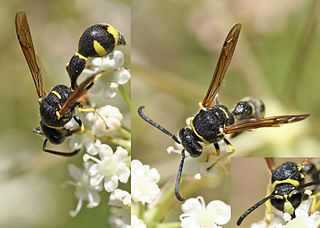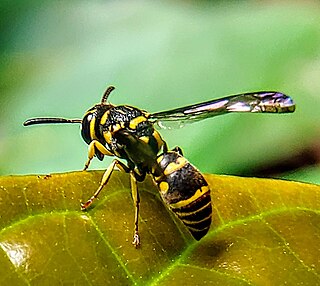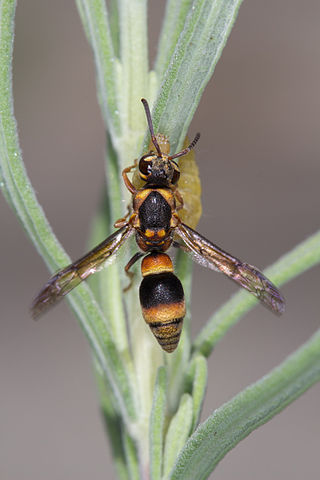
Eumenes is a genus of wasps in the subfamily Eumeninae. It is a large and widespread genus, with over 100 species and subspecies occurring worldwide. The genus was first proposed by Pierre André Latreille in 1802, with the type species later designated by Latreille in 1810. All species make jug-like nests out of mud, usually attached to twigs. The larvae are fed with caterpillars.

Anterhynchium is an Afrotropical, Indomalayan, Australian and Palearctic genus of potter wasps. As in many species of wasp, female wasps defend against predation using a modified ovipositor to sting predators. Like some other wasps in the Vespidae family, male wasps can produce a "pseudo-sting" with two sharp spines on either side of their genitals; however, unlike in the females, this "sting" is venomless.

Synagris is an Afrotropical genus of large potter wasps. Several Synagris wasps are strongly sexually dimorphic and males bear notable morphological secondary sexual traits including metasomal lamellar or angular protruding structures and hornlike or tusklike mandibular and/or clypeal projections.

Delta is an Old World genus of potter wasps with species predominantly distributed through tropical Africa and Asia. Some species are present in the Palearctic region, and a few have been introduced in the Nearctic and Neotropical regions. The members of this genus have a long metasomal petiole, like members of the genera Eumenes and Zeta.

Katamenes is a genus of potter wasps with species distributed in Europe and Africa. When originally named by Edmund Meade-Waldo, Katemenes was monotypic, containing only K. watsoni, but other species have since been moved from Eumenes to Katamenes.
Ischnocoelia is an Australian genus of potter wasps. The species currently recognised under this genus are:

Stenodyneriellus is an Australasian and Indomalayan genus of potter wasps.
Paraleptomenes is a primarily Indomalayan genus of potter wasps. There is a single species, Paraleptomenes miniatus, reported outside of the region, from the island of Mauritius in the Afrotropical region.
Knemodynerus is a genus of potter wasps distributed through the Palearctic, Afrotropical, Indomalayan and Australasian regions. The species currently classified in the genus are:
Lissodynerus is an Indomalayan and Australasian genus of potter wasps. The following species are classified under Lissodynerus:
Leptomenes is a mainly Afrotropical genus of potter wasps. It was previously a much larger genus, though many species have been transferred to other genera such as Eumenidiopsis, Stroudia, and Tachymenes.
Eumenidiopsis is an afrotropical genus of Afrotropical potter wasps with eight known species, which are set out below:
Eustenancistrocerus is an Afrotropical, Palearctic and Oriental genus of potter wasps. The species in this genus include:
Pareumenes is an Afrotropical, Palearctic and Oriental genus of potter wasps.

Paralastor is a very large Australian genus of potter wasps.
Pseudalastor is an Australian genus of potter wasps.
Pseudepipona is a genus of potter wasps found in the Palearctic, Nearctic, Afrotropical and Australian regions.
Zetheumenidion is a small afrotropical genus of potter wasps currently containing 11 species, one of them previously with two subspecies. The species are distributed through southern and eastern Africa.
Labus is an Indomalayan genus of potter wasps. It contains the following species:

Phimenes is an Indomalayan and Australasian genus of potter wasps. The genus was formerly regarded as a synonym of Delta. The genus was separated from Eumenes by the Italian hymenopterist Antonio Giordani Soika when he elevated division IV of Eumenes, which Saussure had given the name Phi to, to full generic status. However, Giordani Soika noted that the name Phi was preoccupied by a subgenus of the New World polistine genus Mischocyttarus and he therefore chose to compound Phi with Eumenes into Phimenes as the name for the new taxon.








